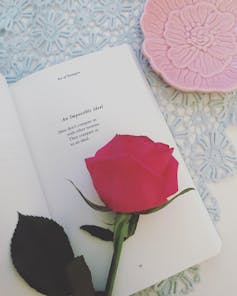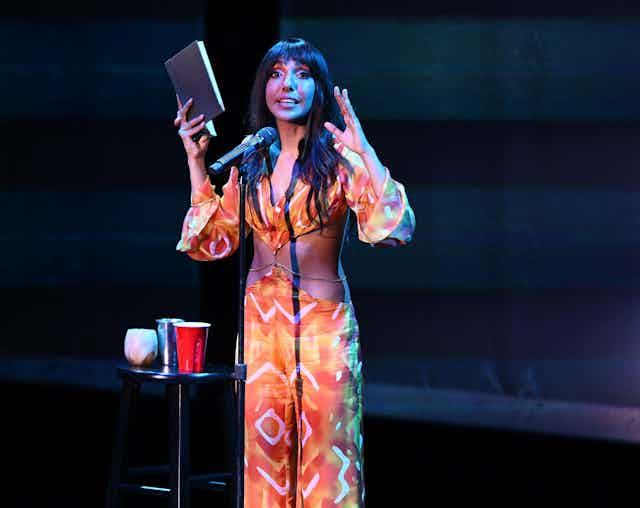It looks like this:
words of encouragement
or about love
divided into stanzas
signed off
with the poet’s name
Instagram poetry has made writers like Rupi Kaur and Donna Ashworth rise to stardom, amassing thousands of followers and earning them quite a bit of money.
As a subgenre of poetry, it combines self-help, reflections on romantic relationships, identity and plain language to create poems that users can quickly grasp and share through hashtags like #instapoetry. Visually, Instapoetry is often accompanied by drawings, uses typewritten fonts and has an overall lack of capitalisation and punctuation.
If you like instapoetry, you’ve likely heard all the arguments for why it’s an unserious sub-genre that shouldn’t be seen as “real” poetry. However, its popularity and its boost to overall poetry sales should be taken more seriously by the establishment – as should young people’s love of it.

This article is part of Quarter Life, a series about issues affecting those of us in our twenties and thirties. From the challenges of beginning a career and taking care of our mental health, to the excitement of starting a family, adopting a pet or just making friends as an adult. The articles in this series explore the questions and bring answers as we navigate this turbulent period of life.
You may be interested in:
Setting low-stakes challenges can help you reach your bigger goals in 2024
Salman Rushdie: where to start with this pioneering and controversial author
While it is hard to track down who created Instapoetry, most sources agree that Lang Leav, a Cambodian-Australian writer, was the first success story. As she gained popularity online, Andrews McMeel Publishing closed a deal with her for her book Love and Misadventure, which has sold more than 150,000 copies.
Since then, Instapoetry has accumulated millions of followers across the web and beyond. Rupi Kaur has sold more than 11 million copies of her books and embarked on an 11-month world tour. The success of Kaur and several other Instapoets has been linked by the publishing industry to a general increase in poetry sales, driven partly by young people.
Poetry for the internet
Key to Instapoetry’s appeal is its accessibility. Instagram enables direct communication between the author and readers, who use the comment section to express their responses to the poem and communicate with each other, creating a community – or at least the sense of one.
The community of Instapoetry-readers is fundamental for the poets. The more interaction their posts or poems receive, the more the content and artwork will be spread.
Instapoetry is no longer bound to the social media platform. As one scholar has put it, Instapoets can seamlessly “shift [their content] from digital to print”, making their work incredibly profitable. Traditional publishers like Penguin, Orion, and Simon and Schuster have added Instapoets to their catalogues.
Poems can now be found not just in books but also on shirts, mugs and even inscribed into people’s skin. Kaur is more than a poet: she is a brand selling tattoos, clothing and prompts to “build more honest and fulfilling relationships.” Instapoet Atticus has a dedicated card on his Instagram profile to share photos of readers who have tattooed his poems.
Meanwhile, some Instapoets have been recognised by literary prizes. Nikita Gill has been shortlisted for the Goodreads Choice Awards, while Tommy Pico, a now multi-award winner, began his career writing on Tumblr.
What about tradition?
Despite all of Instapoetry’s success, some critics have discredited the subgenre for being lowbrow.
In their view, Instapoetry is not poetry, instead resembling “positive affirmations given in self-help guides”. This line of criticism states the subgenre’s flaws are in its insistence on writing based on the author’s experience.
Yet in dismissing Instapoetry as “read-and-feel-good” works, these critics miss a fundamental fact: the literary canon is primarily white, heterosexual and male. So when Instapoets such as Rupi Kaur and Nikita Gill write about migration, race, beauty patterns and rape culture, their words give voice to other women of colour who remain silenced. For this, Instapoetry should be celebrated.

Another common negative evaluation is that its success is a “celebration of amateurism and ignorance in our poetry,” as poet Rebecca Watts declared. For Watts and others, the issue with Instapoetry has to do with its lack of interest in playing with language, tradition and form. But must writers be forced into belated modernism, where rules are torn apart? Should every writer aim to be groundbreakingly novel?
In writing Don Quixote, the first modern novel, Cervantes drew on less serious genres like the chivalry romance to inaugurate tradition. Look at how that book is now considered part of “the canon”.
Critics must realise that Instapoetry has achieved something educators, “serious” poets and politicians have failed to do: renew younger generations’ interest in literature. Because adolescents are now buying books, they may stumble upon more traditional literature and consume it – something less likely if they are not walking into bookstores in the first place. Enjoying Instapoetry does not stop the reader from enjoying “the canon”.
Despite its clichés and excessive self-help style, Instapoetry has renewed interest in poetry, and for that, we should celebrate it. And, if you like these short poems, maybe I’ve given you a couple of arguments you can use when next faced with detractors.
This article was amended to remove suggestion that all critics or academic scholarship in general have discredited instapoetry.

Looking for something good? Cut through the noise with a carefully curated selection of the latest releases, live events and exhibitions, straight to your inbox every fortnight, on Fridays. Sign up here.

